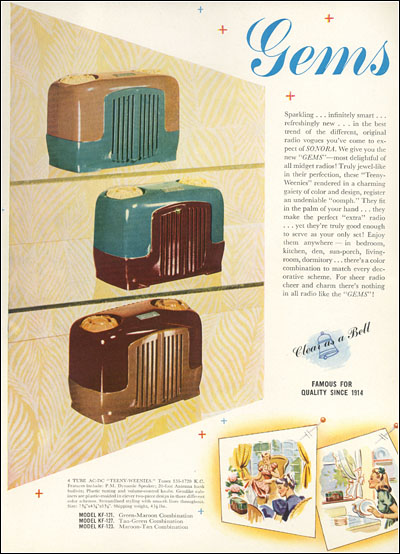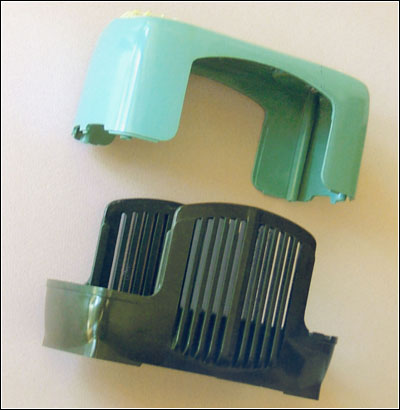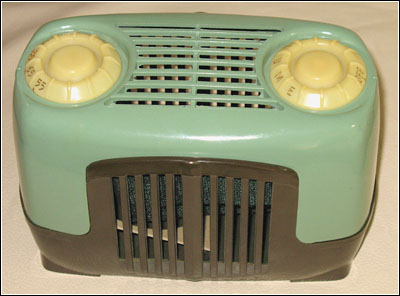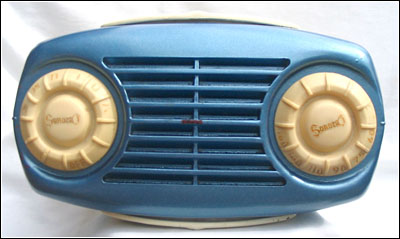Of Old Radios And Related Items--Published Monthly
The Sonora Gem
Sonora's First AC/DC Plastic RadioBY RICHARD ARNOLD
Web Edition
The Sonora Company has once again captured Richard Arnold's attention. Also once again, he has made a direct, personal connection with a company, this time with a designer of a set to be marketed to young people. (Editor)
During the late 1920s and the Depression years, Sonora had many rough times, including going into receiverships and bankruptcy. The company emerged from bankruptcy on March 10, 1938, under the Articles of Incorporation as the Sonora Radio and Television Corporation.
In the spring of 1939 some of Sonora's key employees had evolved into a very effective design and marketing team. They would meet together on a monthly basis to pass around their ideas.
The members of this group were Joseph Gerl, president; Don Fetterman, chief engineer; George Broosky, marketing manager; Virginia Burpo, design assistant; and the company designer, who supplied me with some helpful information. He prefers to remain anonymous and will be referred to as P.W.C. Figure 1 (see print version) shows him holding one of his Gem designs.
It was during one of these meetings that Broosky, the marketing manager told everyone of a need for a small AC-DC radio. The design objective was to make a small plastic-cased radio that would pack easily in suitcases or traveling bags. The idea was to sell it for under $10 to people who were going away to school or traveling to other destinations. The radio should operate under all conditions and would not damage the other contents in the bag.
The sets were to be designed with the necessary "Oomph" to please the college boy or girl and to lend a cheerful companionship to a dorm. Although Broosky had talked about young people wanting color rather than black or white, the design team had no plan for colors until after the first cabinet parts were molded in brown, the typical color for high impact, low cost sets. However, they tried painting white on the brown cabinet and showed it to Broosky for evaluation. His response was "This is it!" The "It" turned out to be the Sonora Gem.
Figure 2. A page from a Sonora pamphlet showing, from top to bottom, the KF-121, a green-maroon combination, the KF-127, a tan-green combination, and the KF-123, a maroon-tan combination.Birth of the Plastic Gem
In 1939, plastic was becoming the logical replacement for wooden cabinets, which required more air space inside the cabinet, and in general, cost two to three times more than a plastic cabinet.
Sonora took its ideas for color to Durez Plastic and the Midwest Molding and Manufacturing Company to see if color could be achieved. Well, it could. Sonora found out that it could make the radio cabinets in a number of different bright colors. Thanks to these two companies, production of the new Sonora Gem was about to become a reality.
Color was entering the market with the manufacture of new plastic materials such as urea and phenolic. The urea plastic was more expensive and more heat-resistant than the phenolic plastic. However, to maintain the target retail price of $9.95, Sonora chose to make most of the sets from phenolic.
The company used the new Durez plastic compounds that remained relatively unaffected by temperature or atmospheric changes, cleaned easily, and would hold its brilliant sheen.
Figure 3. A photograph showing the two different colored sections of a Sonora Gem cabinet.The original series was the KF series, produced early in 1940 in three different color schemes. The numbers are KF-121, 123 and 127. The model numbers were assigned after the cabinets were mated with the chassis. Figure 2 shows a page from a Sonora pamphlet illustrating the models KF-121, 123 and 127.
The cabinet was designed by molding a quantity of several colors and assembling them. For example, with the base or lower section maroon and the upper section green, as in Figure 3, the manufacturer could reverse the color combinations or use either part with another color. The combinations could then cover as wide a range as desired and as merchandising might dictate. The sets were rightly named "Gems."
The KF series Gems were 4-tube AC-DC Superheterodynes that tuned the broadcast band from 535-1720 Kc. They used the following tube types: 12SK7GT, 12SJ7GT, 35Z5 and 50L6.
Figure 4. The Model KF-136, one of the second sets of models.They featured a P.M. dynamic speaker, a 20-foot antenna hank built-in, and plastic (acetate) tuning and volume-control knobs. The radio measured 73/4 x 41/4 x 53/8. It weighed only 41/2 pounds.
In October 1940, the Durez Company featured the Sonora Gem as the "Molding of the Month" in an employee publication called the "Durez Molder." A full-page description and pictures of the new radio are highlighted.
In another bit of Sonora trivia, the Midwest Molding Company factory workers making the molds for the Gem called it the "Garden Gate." The reason was that the dye that they used to make the grille area made it look like a garden gate to them.
Sonora sales for 1940 were $200,000. On a list of 18 companies it was number 14. Sonora was doing better than Detrola, Farnsworth, and Sparks-Withington, and tied with Wells-Gardner.
Shortly after its initial introduction of the Gem, sometime in 1941, Sonora introduced a second group of Gems in new colors inspired by the Sonora Coronet, which had a Catalin cabinet. These new model numbers were KF-135, 136, 137, and 145. The Model K-136 is shown in Figure 4.
In 1940-1941, Sonora was enjoying the response to its designs in the marketplace. The company was producing more radios than ever before, and the range of products seemed to cover all tastes and pocketbooks. Looks like those monthly group meetings were paying off.
A sales ad for the new line of Gems reads as follows: "They've made a real hit -- These sparkling, infinitely smart and refreshingly different 'GEMS'! AND now we present them in NEW COLORS, smart colors that take their inspired cue from the 'CORONET'! Most delightful of all 'TEENY-WEENY' radios and truly jewel like in their perfection. There is nothing in all radio like the Sonora Gems."
Although these plastic sets had become enormously popular, a shift to paint in the 1940s was necessitated by a shortage of urea. Sonora could no longer get the original colors of urea used in its first models and had to use whatever could be found. Fifty-pound bags of surplus urea in a variety of colors were gathered from other molding companies. Since the supply of plastic was limited, and the colors varied, it was logical to start painting the radios to try to meet the original color specifications.
My Sonora Gem
The radio shown in Figure 5 (see print version), 6 and 7 (see print version) is from my collection. This is a later WJU series model with a painted cabinet and a different tube lineup from that of the original KF series. It uses the following four tube types: 12AT6, 12BE6, 50B5 and 35W4.
The top of this radio is painted a very deep vibrant aqua blue color while the base is a creamy ivory color. Where the paint has chipped off, I can see the brown color of the plastic material that is under the painted areas. The word "Sonora" appears on the knobs. Note that the knobs have "Sonora" molded in their center; the knobs for the early Gem models series did not have this designation, as can be seen in the Model KF-136 in Figure 4.
I am not sure of the model number or the date of manufacture; however, my Sonora catalog shows that the WJU series of Gems is from at least 1946.
Some of the features of this model are similar to those of the KF series, except that it tunes the broadcast band from 530-1620 Kc. It has an antenna built into the line cord. The "U" in the model prefix meant that the chassis was Underwriters approved.
Ever since my first article on Sonora in A.R.C. in April 2007, I have become very interested in this small, fascinating company. I am always on the lookout for Sonora-related information. One example is the dealer punchboard, shown in Figure 8 (see print version), that, for a small fee, allowed a customer a chance to win a new Gem (or Airmaster) radio.
Figure 6. A top view of Arnold's Sonora Gem. Note the word "Sonora" in the center of the knobs.I want to thank P.W.C. for all of the information and personal insight he has so freely shared with me about the Sonora Company history and the development of the Gem radio, as well as about his design of the set.
Because Sonora was a small company, it could do things more easily and faster than a larger company could. For P.W.C., who is now 91 years old, working for Sonora was a very pleasant experience.
References:
"As Good as Gold." Chicago: A Mitchell Manufacturing Company dealer promotional pamphlet.
"Durez Molder." North Tonawanda, New York: Durez Plastics & Chemicals, Inc., October 1940.
"Listen America" Sonora sales catalogs for 1941, 1942, and 1946.
Maclaurin, W. Rupert. Invention and Innovation in the Radio Industry. New York: The MacMillan Co., 1949
P.W.C., Designer of Sonora Gems, 1938 to 1943. Photos of Sonora Gem Model KF-136 and personal recollections of company policy and history.
Sams Photofact folder, Sonora Model WJU-252, Set 36, Folder 23.
Richard Arnold, a frequent contributor to A.R.C., has been collecting radios since 1985. His interest is primarily in cathedrals and 1920s battery sets, and his collection ranges from crystal sets to a 1928 Bosch in a Pooley cabinet. His prize is the 1932 Jackson Bell Peter Pan featured in the June 1991 A.R.C.
|
[Free Sample] [Books, etc., For Sale] [Subscribe to A.R.C./Renew] [Classified Ads] [Auction Prices] [Event Calendar] [Links] [Home] [Issue Archives] [Book Reviews] [Subscription Information] [A.R.C. FAQ]URL = http://www.antiqueradio.com/Jul08_Arnold_Sonora.html Copyright © 1996-2008 by John V. Terrey - For personal use only. Last revised: July 1, 2008. For Customer Assistance please contact ARC@antiqueradio.com or call (866) 371-0512 toll free Antique Radio Classified |



